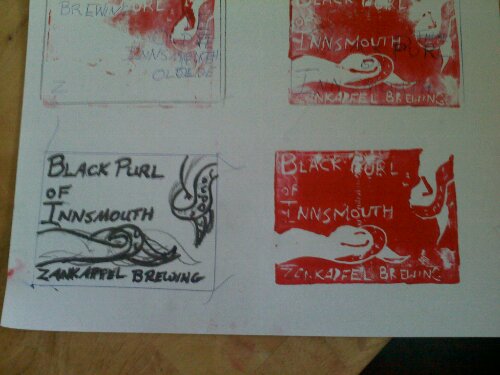Batch #005 – Black Purl of Innsmouth (Ginger + Licorice Purl)

The design and finished product. I’m not pleased with how the negative space rendered… I think this label will need a redo. Good thing each of these stamps have 2 sides! (Also, I won’t use red for the official labels. This was just a test stamp.)
Yes. That references what you think it does. No. It’s not spelled wrong. I know I’ve talked about it quite a bit, because it’s a very ‘out there’ beer for the simple fact that wormwood is hard to use. Yes, wormwood. No, we’re not hallucinating. Without getting into the chemical explanation, the bit of wormwood used is very light. I only added about a 1/2 oz for a five gallon batch of beer. Even vermouth uses more than that. And this seems to even be more than I needed. If I make this again, I might cut it down to a 1/4 oz.
A purl is a type of gruit. Gruits are beers that use something other than hops as a bittering (and therefore, preserving) agent. Common gruit adjuncts include spruce tips, yarrow, marigold, juniper, and heather. Purl is specifically a gruit which specifically uses wormwood. Based on economics and ecologics, a fair amount of older styles of beers don’t use hops like they are used today. Hops contain alpha and beta acids, which allow for longevity of the beer. IPAs, for example, are known to be hoppy. They were originally brewed to be shipped by boat from Britain to India, and needed to survive the long journey. Nowadays, hops are used for their own aroma and flavor. So with wormwood being somewhat more local, it was collected and used in these purls. Wikipedia says about purl: “The drink was commonly drunk in the early hours of the morning at which time it was popular with labourers.“
So yes, I made a wormwood beer with a H. P. Lovecraft reference. But consider my audience! This beer is made for my Call of Cthulhu RPG group. Yes, I am a nerd who gardens and brews. I’ve been playing with the group for a couple of months now, and my cryptozoologist is proving somewhat useful. Maybe if I get dead, I should be the owner of a local brewhouse?
Anyways, let’s get on to the recipe and a few tasting notes that I have at this point. The wort recipe is based around a Cascade black ale recipe because I wanted something dark that went well with bitterness.
Black Purl of Innsmouth (Ginger + Licorice + Wormwood Gruit / Purl)
– Bring 3 Gallons of water to 170F
– Steep: 1# Crystal Malt, 8oz Roasted Barley, 1# Carapils, 8oz Carafa II for 30 min
– Let drain
– Bring wort to boil
– @60 – 3.3# Coopers Light LME
– @30 – 3.3# Coopers Light LME, 2oz crystalized ginger (chopped into tiny pieces)
– @10 – 3.3# Coopers Light LME, 1/2 oz licorice (dried+shredded root), 1/2 oz wormwood
– Remove from heat and cool to 75F
– Scrape in licorice and wormwood from pot
– Fill to 5 gallons
– Pitch yeast: WYeast 1764 – Rogue Pacman Yeast
The wort tasted extremely bitter and I was worried I had messed up the beer. It was also very sweet, but that meant that it would likely have a high ABV.
After a week, I moved it into secondary, the sweetness of the wort had been changed to booze. But the licorice still had a noticeable sweetness. I added another 1/4 oz of licorice to the secondary. The wormwood had a very medicinal flavor that still had me worried.
Two weeks later, I bottled it. The wormwood had mellowed out and wasn’t as strong, but still tasted medicinal with hints of orange pith. SpecSO totally dug it, though, and drank the remainder bottle (the bottle which doesn’t get totally full) all by himself.
I’m going to let this sit for another month before I revisit it. It certainly has potential and is very exciting!